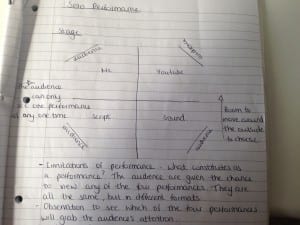After being interested in Amy Taubin’s manipulation of the audience’s view, I began to think more about what I wanted my performance to be about. I sketched a rough idea for the set.

My intention began by creating a performance with four different perspectives. Audio, human form, a written script and a performance omitted through a computer screen. Each performance would be hidden in each section, giving the audience the chance to only view one at a time. These would be four of the same performance, giving the audience the choice to move around the four sections.
However, this format became apparently problematic. I realised that the audience might not know when to move to the next section, the noise from one section could clash with that from the other. I realised if I wanted to make my intention clearer I would have to amend the way these four mediums would be viewed. So I decided one medium would need to consecutively move into the next:
1. Sound and no visual, audience in darkness – the least intimate
2. Computer Screen – the performer is blocked by the barrier of the screen
3. Actual performer – they are there in the flesh
4. Close up on facial expression – most intimate
These four mediums, each in turn showing a part of the performance, would be in the same space in front of a seated audience. After discussion, I worked through the idea and settled on the theme of intimacy in performance.
Bertolt Brecht

Like Bertolt Brecht was, I am interested in the image of the performer and how close or how far away they are from reality and the audience. Brecht’s ideas originated from his dislike towards the emotional manipulation brought about by the theatre and the Nazi movement. Brecht used his skills to create techniques which broke down the wall between performer and audience, “subverting the emotional manipulations of bourgeois theatre” (Bogad, 2014), in the 1930s. One of the techniques he used was the alienation effect:
“The alienation effect attempts to combat emotional manipulation in the theater, replacing it with an entertaining or surprising jolt. For instance, rather than investing in or ‘becoming’ their characters, they might emotionally step away and demonstrate them with cool, witty, and skilful self-critique” (Bogad, 2014).
My aim is to mirror the intimacies in performance, with the intimacies brought about by technology. Performances in present question the presence of the audience on a regular basis. Take Marina Abramović in Rhythm 0, for example, when she placed a gun on a table she questioned how far an audience would go. When an audience member picked up the gun, their movement made a great impact on the emotion of the performance. This is described in the video below.
)
This reversal of emotion is an interesting subject to explore. Abramović became the subject of manipulation as the audience chose what do with her. In another way, would you feel as emotionally involved watching a performance through the barrier of a computer screen, as you would if the performer was standing right in front of you? These are questions I am considering exploring in my performance.
Works Cited
Abramovich, M. (2013) Art Marina Abramović Rhythm 0. [online video] Available from http://www.youtube.com/watch?v=BwPTKmFcYAQ [Accessed 13 March 2014].
Bogad, L.M (2014) Theory: Alienation Effect. [online] Beautiful Trouble. Available from http://beautifultrouble.org/theory/alienation-effect/ [Accessed 13 March 2014].